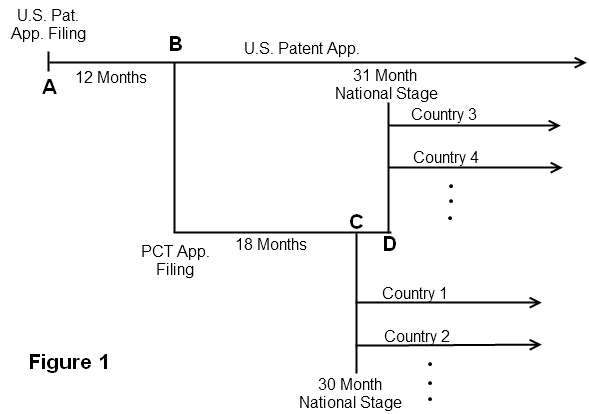Generally, you cannot obtain a single patent that is effective in every country in the world. Patent protection must generally be secured in each foreign country or jurisdiction through a local patent in that country or jurisdiction. However, regional patents exist that span across multiple countries. One example of a regional patent is a European patent, where European member countries of the European Patent Office (EPO) recognize EPO patents.
Apart form regional patents, there exists an international patent application called a PCT patent application that provides a process for reserving your right to file patent applications in foreign countries and participating regions, such as the EPO.
Paris Convention v. PCT
For member countries of the Paris Convention, generally foreign patent applications must be filed within 12 months of the earliest national application filed in a member country. Therefore if the applicant first filed a patent application in the United States, the applicant would have 12 months from the U.S. filing to file foreign applications in Paris Convention member countries claiming priority and receiving the benefit of the filing date of the U.S. patent application.
The PCT (Patent Cooperation Treaty) application process generally gives the applicant an additional 18 months to consider whether and in which countries to pursue patent protection. If the applicant first filed a patent application in the United States, then filed a PCT application within 12 months of the U.S. filing, the applicant would generally have an additional 18 months to nationalize the PCT application in the foreign countries in which the applicant desired patent protection.
However some PCT member countries do not provide the full 18 months for nationalization, but instead require nationalization at a much sooner time. It is important to consult early in the process with an attorney regarding the deadlines that would be applicable to your case.
PCT Member Countries
Over 140 countries are PCT member countries. Therefore by filing a PCT application, you can reserve your option to pursue patents in over 140 countries. Not all countries are PCT member countries. The PCT application process has two steps, the international stage and the national stage. Residents or nationals of any PCT member country are eligible to file a PCT application.
International Stage
A PCT patent application must be filed within 12 months of the first filing of a national patent application (such as a U.S. provisional or non-provisional patent application). An example application process flow is provided in figure 1 below.
The example of in figure 1 shows that at point A a U.S. Patent Application was filed. Then 12 months later at point B a PCT application was filed claiming priority to the U.S. Patent Application. It is also possible to file the PCT application first before any national application.
The PCT application can be filed through a receiving office in PCT member countries, such as the U.S. Patent and Trademark Office or through the international bureau at WIPO.
After the PCT application is filed, an International Searching Authority (ISA) will perform a patentability search and issue an international search report. The ISA will also issue a written opinion on patentability. The applicant has the option to withdraw the application in light of the search report or written opinion, if this is not done the application and the international search report will be published. The PCT application will generally be published 18 months after the earliest priority filing date (such as the first national application filing date).
The PCT applicant can request a second or supplementary international search which may be carried out by one or more of the ISAs (other than the one that carried out the main international search) resulting in a supplementary international search report. The PCT applicant has the opportunity to amend the claims in the patent application in response to the search report.
Optionally, the PCT applicant can request a Chapter II Examination international preliminary examination resulting in an international preliminary report on patentability.
National Stage
The PCT application must be “nationalized” (entered into the national phase) into the particular foreign countries or jurisdictions that you would like to have patent protection in. Once the application is nationalized in a particular country, the application will be examined under the local laws of that country to determine whether a patent should be granted.
Therefore if you wanted to have foreign patent protection in China, Australia, and in Europe, you would need to nationalize the PCT application in each of those jurisdictions by the nationalization deadline (see below) in order to seek patent protection there.
The deadline for nationalizing the PCT application depends on the country. Most countries or jurisdictions require the application to be nationalized within 30 months of the earliest filing date (the earliest claimed priority application filing date) other countries or jurisdictions require nationalization within 31 months. However, as explained above, some PCT member countries do not provide the full 18 months for nationalization, but instead require nationalization at a much sooner time. It is important to consult early in the process with an attorney regarding the deadlines that would be applicable to your case.
The earliest claimed priority date in the example of Figure 1 is the date that the US application was filed, not the date that the PCT application was filed.
At point C in figure 1, nationalization occurs regarding Countries 1 and 2 at the 30 month deadline. At point D in figure 1, nationalization occurs regarding Countries 3 and 4 at the 31 month deadline. Nationalization might occur into a regional patent organization, such as the European Patent Office, rather than a country.
Individual countries or regional patent organizations many provide a grace period or revival period allowing the nationalization even after the deadline. Therefore if you have missed the nationalization deadline, you should inquire with an attorney whether there are still options for nationalizing your application in the countries you choose.
Nationalization usually involves the payment of nationalization fee, filing of certain documents, and in some cases, filing of a translation of the application. Then the nationalized application will be considered under the local laws of the jurisdiction to determine whether a patent should be granted. Local attorney representation will likely be needed in the nationalized jurisdictions to prosecute the application under their local laws. Generally your U.S. lawyer can work with foreign attorneys during the local prosecution of the application in the national stage.
Cost
Pursuing patent protection by nationalizing a PCT application in every PCT country is generally not economically feasible. The need to hire local attorneys and prosecute the applications in each of 140 countries would be an very expensive endeavor.
Instead, clients often, at or before the nationalization deadline, choose to nationalize the PCT application in countries where they have (1) actual or anticipate sales or (2) actual or anticipated licensing or business opportunities sufficient to justify the foreign patenting expense.
The PCT international patent application filing fee is around $4000. The nationalization fees can range from $2000-$7000 per country to file. After that there are prosecution costs in each country until the application hopefully issues within a few years as a patent. There are also yearly patent application fees and patent annuity fees to be paid in each country.
Conclusion
Seeking foreign patent protection involves considerable costs. However, foreign patenting can be valuable when undertaken with a targeted approach that is aligned with the appropriate business case.

